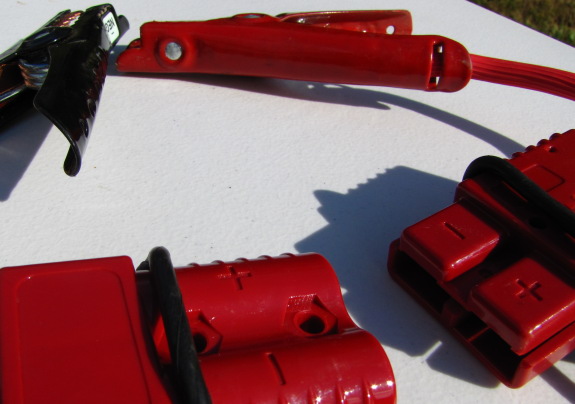
DIY Super Winch 12 volt extension-jumper cable
The plan is to modify one end
of a good pair of jumper cables with the above quick connector, and
hook the other quick connector to the Super Winch.
A 20 foot set of jumper
cables is about 4 feet shy of making it to the battery. What I need to
research is the possibility of only having one strand reach all the way
to the positive portion of the battery and have a frame contact near
the bumper to connect a shorter negative strand clip to. This would
allow me to splice enough onto the positive side to reach the battery
and have plenty left over to make a short strand for the negative frame
connection.
I know a splice looks a
little sloppy, but is it still just as functional as a continuous
strand?
Want more in-depth information? Browse through our books.
Or explore more posts by date or by subject.
About us: Anna Hess and Mark Hamilton spent over a decade living self-sufficiently in the mountains of Virginia before moving north to start over from scratch in the foothills of Ohio. They've experimented with permaculture, no-till gardening, trailersteading, home-based microbusinesses and much more, writing about their adventures in both blogs and books.
Want to be notified when new comments are posted on this page? Click on the RSS button after you add a comment to subscribe to the comment feed, or simply check the box beside "email replies to me" while writing your comment.


This winch can pull 320 ampere when running slowly at full load. The startup current can be even higher. This is significantly more than e.g. the starter motor.
For normal electrics, I'd say a soldered splice should be as good as the original wire. If you don't solder the splice, I think the resistance will be too high, heating up the cable.
But for a high-current application like this I'd prefer as few connections as possible. Better to go to a hardware store and have cables of the right rating cut to size and connectors crimped on.
To get a high startup torque, the coils of the stator and rotor of motors like starter motors and winch motors are generally wired in series. If the motor is standing still, there is no changing magnetic field to induce back-emf (practically raising the resistance) in the coils, so it draws a lot of current. If such a motor is prevented from rotating with the power on, it will eventually overheat and break (short out). That is why the winch whould have a built-in circuit breaker. If it is a fuse; get some spares.
Roland-I wasn't aware of back-EMF. That piece of information has pushed me over the edge into not having a splice.
Zimmy-If I had to make a splice without a trip to the store I would try that copper pipe trick. Sounds like it could be a solid connection if it was done right and soldered completely.